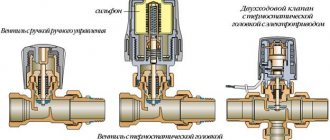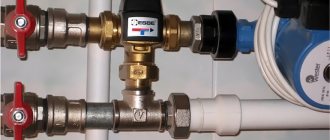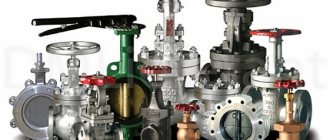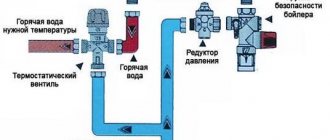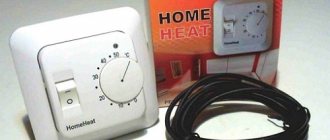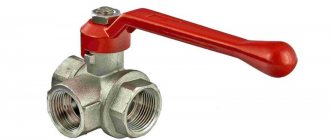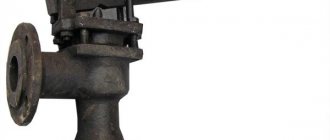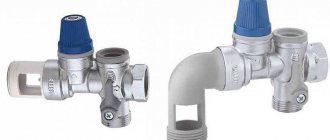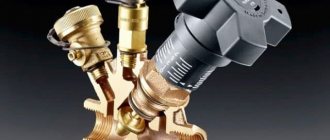What is it and what is it for?
The optimal modern heating method is to install heated floors in the house. A warm floor allows you to evenly heat the entire room from below and not waste heat on heating the air under the ceiling, heating only the necessary rooms or even their individual areas. Heating using a heated floor system allows you to save up to 30% on fuel and finances compared to floor and wall heating.
The heated floor system uses a coolant with a maximum temperature of +45 °C, and boilers heat the coolant to a temperature of 80...90 °C. Therefore, to ensure the required coolant temperature, a device is needed that mixes hot water from the boiler and cold water from the return. It is very important for the floor not to exceed the temperature of the coolant. A three-way mixing valve is used as this device in the manifold assembly.
Purpose and scope
A three-way valve is used to regulate the temperature of the coolant in pipelines embedded in the floor screed.
Warm floors are not yet very widespread in our country; they are mainly installed in private homes. But people are gradually realizing the reliability of this heating option and seeing savings, and heated floors are gradually gaining popularity in both public, office and administrative buildings.
If you weigh all the pros and cons of using underfloor heating, the significant savings outweigh the high cost and complexity of installing the entire system.
Characteristics
Features of mixing valves include:
- Control method: mechanical or electric drive.
- Diameters of pipes.
- Operating pressure. All three-way regulators are designed for a pressure of at least 1.6 MPa, and in a private house in a floor heating system the pressure does not exceed 0.2-0.3 MPa, so when purchased, any valve with a nominal pressure is suitable for a private house.
- Bandwidth.
What materials are they made from?
Three-way mixing valves are made from the following materials:
- Brass. The copper alloy with the addition of zinc is not subject to corrosion, brass fittings are strong and durable. Sometimes brass products are coated with chrome or nickel for aesthetic purposes, since the metal darkens over time. This is the most common material for heating control devices in residential buildings.
- Bronze. Also an alloy of copper with tin, aluminum, silicon, beryllium. The quality is not inferior to brass, but is rare.
- Stainless steel. Excellent material for control valves. Its durability, corrosion resistance and strength are higher than that of brass. But stainless steel is more expensive, and it makes no sense to use such regulators in a private home.
For three-way control valves, titanium and carbon steel with a protective coating are also used, but these are rather options for industry. Ceramics are not used; they cannot withstand endless operation. Occasionally there are cheap products made from silumin - an alloy of aluminum and silicon. The quality of silumin products does not stand up to criticism - they fail very quickly.
Almost always, brass three-way valves are used for installing underfloor heating systems in a private home.
Operating principle and device
To regulate the degree of heating of the coolant in a heated floor system, a three-way mixing valve is used, which has one output and two inputs. Operating principle: two streams enter the device - hot and cold water - and are automatically mixed in a certain proportion.
The proportion is determined by the thermostat setting. The valve does not change the pressure in the pipeline (except for minor losses when water passes through the fittings). There are models with an electric drive - they allow you to very accurately regulate the temperature of the coolant.
The valve design includes a body, control elements (spools) connected to the stem, a thermal head that controls the stem and, through its movement, the spools. The body has seats with seals. When the rod is turned, the spools rigidly connected to it slightly open or shut off the flow of cold or hot water, changing the temperature of the water at the outlet of the valve.
The rod is turned by a thermal head, which is triggered when the temperature of the outgoing coolant rises and falls. Electrically driven devices are triggered automatically: it turns on if a command is received from temperature sensors.
There are three-way valves, the design of which is based on a ball valve. The regulatory body here has the shape of a ball or sector with a hole of complex shape. The rod in such drives rotates.
The design and principle of operation of a three-way valve in a heating system
So, first of all, let's look at the device. To make it easier to understand what’s inside the valve, you need to look at the photo below, which shows the device in cross-section. It consists of three pipes (two side, one bottom), between which the mixing chamber is located. On the fourth side (top) there is a thermal head responsible for controlling the temperature of the coolant.
Sectional view of a three-way valve
Inside the device, from the thermostat there is a spring-loaded rod with two flat round valves. Their diameter corresponds to the diameter of the nozzle seats. Instead, one ball valve can be installed, located inside the mixing chamber between two seats. When there is pressure on the rod, the valves partially block the flow from the lower pipe and open the upper one. The same thing only happens the other way around if the rod rises up.
But here you need to figure out what laws the rod works by, under what force it lowers or rises. It's all about the thermal head itself. Inside it is a temperature sensor filled with a special liquid. She is heat sensitive. As soon as the temperature of the coolant begins to rise, the liquid expands and rises through the capillary tube into a special bellows (container), which is located in the thermal head. The reservoir itself begins to expand, which puts pressure on the rod. The latter lowers and opens the lower pipe, from where cold water flows into the three-way valve. Hot water comes from the left pipe (see photo).
Separating and mixing valves
Of course, pressure simply cannot happen with any increase in water temperature. To do this, a temperature gradation is installed on the thermal head, which is adjusted manually. It is the set parameter that is the moment of pressing the rod.
So, the rod reacted to the change in the temperature of the coolant in the supply pipe, opened the lower one for cold water, and inside the valve the hot and cold media were mixed to the required temperature. That is, it turns out that the temperature of the coolant at the inlet has not changed, but at the outlet it has become lower.
If the coolant continues to heat up, the rod can drop to the lowest possible position. That is, it will completely close the hot water supply and completely open the cold water supply. And this will continue until the coolant inside the heating system drops to the required temperature. After which the top valve will open, it will release hot water.
Scheme of mixing coolant with return
This is how a three-way mixing control valve works. As for the separation model, its operating principle is almost the same, only in reverse. The coolant enters one pipe; inside the device body it is divided into two streams and exits through two adjacent pipes.
This type of shut-off valve is installed in those areas where the coolant flow needs to be divided into two circuits. One of them will have a constant thermal regime, the other will have a variable one. The first is the fluid flow, which has quality requirements. The second with quantity requirements. In this case, purely structurally, the flow with a constant hydraulic regime is never blocked, because in the design of the device, the length of the rod is made in such a way that the valve does not close the constant circuit.
But it is necessary to indicate that the length of the rod can be adjusted. This makes it possible to adjust the required volume of coolant on a constant circuit. As for the variable, it can completely overlap. This is how the flow and pressure of the coolant in the heating system is regulated. As you can see, the operating principle of a three-way valve is quite simple. The main thing is to accurately select the type of device and install it in the required location in the circuit.
How does a three-way thermostatic valve work in a heated floor system?
To make it clear how the circuit with the valve works, we can give an example of coolant circulation in a heated floor system. The three-way valve for underfloor heating is a mixing valve. The circulation scheme here is as follows:
- hot water enters the underfloor heating system through the collector;
- it must have a certain temperature, which is monitored precisely as it passes through the three-way valve;
- as soon as its value exceeds the permissible value, the valve opens one of the circuits, which is connected to the heating return;
- cooled coolant enters inside, lowering the temperature,
- after which the mixed water enters the heating circuit of the heated floor;
- as soon as the temperature drops to the required value, the return circuit inside the valve is closed with a rod.
Piping for underfloor heating with a three-way valve
Advantages and disadvantages
Advantages of three-way mixing valves:
- Simple design.
- Stable regulation.
- Reliability.
- Tightness.
- Sufficient adjustment accuracy (maximum accuracy – up to 1°C).
- Durability.
- Relatively compact dimensions.
The biggest advantage of using three-way valves is that the pipelines and, accordingly, the screed and floor covering do not overheat, which prevents premature failure of the screed and coating.
Flaws:
- The hydraulic resistance of three-way designs is higher than that of a conventional two-way valve.
- The design of the body and spool allows for the presence of stagnant zones - periodically you will have to dismantle the device and clean it of scale, debris, and organic impurities.
- Insufficient accuracy of room temperature control. The control valve quite accurately regulates only the temperature of the outlet coolant, and the temperature of the heated room - approximately.
To ensure a comfortable level of heating, you will have to select the ratio of the temperature of the outlet flow and the temperature in the room “at random”. Unfortunately, the underfloor heating pipelines are much larger than the radiator, and it is impossible to ensure accurate adjustment. The situation is further complicated by the inertia of the heated floor - a 100-mm cement screed warms up very slowly.
But if you are stoic about slowly heating or cooling a room, then a valve with mechanical adjustment is quite suitable for use in the heating system of a private house or apartment.
Much greater comfort is provided by electrically driven valves controlled by a smart home system with temperature sensors in each room. But such devices are very expensive.
Installation of a thermal mixer for heated floors
Correct installation of a three-way valve on a heated floor involves not only connecting the equipment to the pipeline, but also carefully checking it. Mistakes can lead to big troubles. Installation of the device is carried out when connecting the collector and before pouring the concrete screed for the heated floor. At this stage, the system is fully assembled and tested at a media temperature of no higher than 22-250C. The build quality testing period must last at least 24 hours. After making sure that the system is working correctly and there are no leaks, you can complete the installation.
To connect a three-way valve for heating with a thermostat for a heated floor, use ordinary wrenches. They are used to screw the internal/external thread of the device onto a fitting or union nut of the pipeline. The tightness of the connection will be ensured by plumbing flax, FUM tape or other materials. Special silicone gaskets are supplied with the faucet. When working, you need to make sure that they are laid in the socket, otherwise a tight connection cannot be achieved.
During installation, avoid:
- excessive impact on the threaded connection;
- distortions of pipes, especially at joints;
- loose or loose screwing.
Installing a faucet is a crucial moment, since its operation and the threaded connections obtained during installation will be exposed to moisture and high (differences) temperatures. Therefore, all work must be carried out carefully and accurately. The process of assembling the mixing unit is completed by adjusting the three-way valve for the heated floor using a head. If you don’t have confidence in your own abilities, it is better to leave the installation and purchase of the necessary equipment to assemble the system to professionals. Remember: a warm water floor can cause not only damage to the floor covering, but also the inability to create optimal comfortable living conditions in the rooms. For all questions regarding underfloor heating, please contact our specialists.
Kinds
Three-way valves are classified according to their operating principle. There are separation and mixing valves. Heated floor systems (and radiators) use mixing devices that regulate the temperature of the outlet coolant by mixing cold and hot water.
According to the method of actuation, three-way devices are:
- Manual. They are very rare and inexpensive. Convenient if heated floors are installed in 1-2 rooms - for example, a bathroom and a children's room.
- Automatic.
In manual modes, the position of the rod and the temperature of the outlet water are adjusted manually using a handle. In automatic ones, the movement of the rod is controlled either by a thermal head or by an electric drive controlled by automation with temperature sensors.
Automatic valves are:
- The simplest type is with a thermostatic head. They are triggered when the temperature increases (they react to an increase in pressure). Such devices are used for radiators. The fluid in the actuator expands as the temperature increases and drives the rod.
- With thermostatic head and remote sensor.
- Electrically driven. The rod is driven by an electric motor. The engine is controlled by a controller that receives signals from temperature sensors. The actuator can control the valve using a solenoid (magnet) or a mechanical transmission (servo).
- In production, systems with large pressures and diameters use pneumatic or hydraulic drives.
Types of valves are shown in the photo:
Valve markings
Three-way valves are marked with letters and numbers:
- Company name.
- Series and model number (for example, VTA 321).
- Nominal diameter in mm (DN 20).
- Temperature regime, for example 20-45C - regime from 20 to 45 °C.
- Throughput in m³ – KVS 1.6 – 1.6 m³/hour.
An example of an ESBE valve marking looks like this:
ESBE VTA 321 DN 20 20-45C, kvs 1.6
Standard sizes: ½", ¾", 1″, 1¼" and so on, or in mm - 15, 20, 25 mm, etc.
How to choose
Installing a heated floor, even in a private house, is a rather complex engineering system with ambiguous results. If the adjustment is poor, all the benefits may disappear, so you cannot save on the manifold assembly and control valves. Good three-way valves are not cheap, and there is a high probability of purchasing low-quality products on the market or on the Internet.
For a heated floor system, it is better to buy equipment in a hypermarket or specialty store. A certificate is a must! Or a passport with a “wet” stamp and a completed guarantee. The receipt must be kept.
Usually they buy products made of brass. Stainless steel valves are more expensive and less commonly sold. Silumin is not even worth considering - products made from it do not tolerate constant opening and closing, and the control valves cost a lot.
When purchasing in a store, you need to inspect the valve to ensure there are no chips, cracks, or jams. You need to try to look inside the valve - on brass products without coating, the inside should be golden (and not white-silver, like silumin). You can navigate by weight. Silumin products weigh much less than brass ones - the density of brass is approximately three times greater than that of silumin.
Popular manufacturers
In first place in terms of quality are the products of the Swedish company ESBE. The company has been producing pipe fittings for various purposes for over a hundred years. The second place is occupied by the American company Honeywell. Fittings from HEIMEIER, HERZ, Navien, Danfoss, Mut, Oventrop, Siemens are common. The cost of these products outstrips the quality. The products of the joint Italian-Russian manufacturer Valtec have a more reasonable price.
approximate price
The table above is the prices for a Three-way valve with a thermal head. To find out how much equipment costs in your region, it is better to contact the nearest construction hypermarket. Approximate prices for a three-way valve with electric drive:
How to choose the right three-way valve
The key parameter of any three-way valve is throughput, i.e. the volume of water that the device is capable of passing through itself per unit of time. When choosing a device, you should correlate this parameter with the performance of the boiler.
There is one more nuance to take into account here. Even if the diameter of the valve inlets and outlets seems appropriate in terms of dimensions, this in no way indicates the actual throughput of the device. This parameter is entirely determined by the internal cross-section of the holes, which, depending on the design, are blocked by a ball lock or an adjusting head.
In some models, the dimensions of this hole may be 4 times smaller than the inlet diameter. In order not to make a mistake and not find yourself having to remake an expensive unit, you should carefully study the accompanying documentation before purchasing.
Another important parameter of the device is the cross section. Ideally, the valve should exactly fit the dimensions of the heating system pipes. If an exact match cannot be achieved, you will have to purchase additional adapters.
In addition, it is worth paying attention to the following nuances:
- Be sure to check the availability of accompanying documentation: warranty cards, installation and operating instructions, certificates and licenses.
- When choosing a material, you should give preference to brass or bronze. It is these metals that are best combined with hot liquids and also have a low level of thermal expansion. Products made from non-ferrous metals can be distinguished by their weight - they are much heavier than cheap “stampings” made from powder pressed materials that do not have the proper level of strength.
As for specific models, on the market you can find products from several companies that have long established themselves as reliable manufacturers:
- Esbe . A Swedish company whose products are distinguished by reliability, good performance and attractive appearance. The warranty period is at least 5 years.
- Valtec . A Russian-Italian joint venture producing thermo-mixing valves that combine affordable cost and good technical characteristics. The warranty for the entire range of devices is 7 years.
- Honeywell . An American manufacturer that has prioritized the ease of installation of its products. Three-way valves of this brand have a bright design, high reliability, but no less high cost.
We recommend that you familiarize yourself with: Features of the faucet axle-box design for a mixer, independent replacement and repair of the device
Installation and operation rules
Installing a three-way valve into the underfloor heating system of a private house is not too complicated; it can be done with your own hands. It is necessary to strictly follow the instructions, which are supplied by the manufacturer with each product.
The following letters are stamped on all inputs and outputs of the three-way valve:
- A – supply of the main coolant (hot water). Usually this section is on the same axis with the outlet pipe.
- C – second input to the valve. Usually located perpendicular to the axis of movement of the coolant.
- AB – exit. Located on the same axis with the main input.
When installing equipment, it is necessary to provide for the possibility of dismantling and inspection - there must be free access to the valve.
Required tools and materials
To install a three-way valve you will need:
- Two adjustable wrenches.
- American union nuts equipped with gaskets.
- Possibly FUM tape.
Work progress
The valve is installed in the system using American union nuts. Before installation, clean the ends of the pipes (more precisely, the fittings at the ends of the pipes) from dirt, burrs, sand, and dust. The same is done with the valve pipes. Check the presence of gaskets in the nuts. Screw the nuts onto the pipes and tighten slightly. In this case, tighten the nut with one wrench, and hold the valve with the second. A mechanical filter must be connected in front of the valve.
It is important to position the valve correctly: a hot water pipeline is connected to input A; B – bypass from the return; AB is the collector to which the heating pipelines are connected.
When installing, the actuator must not be above the valve.
Installation video
In the video you can see all the intricacies of the correct installation of a three-way valve for a heated floor.
Features of operation
It is imperative to install a filter in front of the valve.
It would be a mistake to install a valve with a thermal head in a system that regulates underfloor heating in several rooms or is located in another room (and in a tightly closed distribution cabinet). It is necessary to install equipment with remote sensors located in a heated room.
Frequent errors and problems during installation
The most significant mistake when installing a three-way control valve is to incorrectly connect the pipelines with incoming and outgoing coolant (for example, when a pipe for supplying coolant to the heating circuit is connected to the inlet pipe). You must be careful when installing equipment. The letters on the pipes indicate the purpose of each outlet; if connected incorrectly, the three-way valve will not work.
It is necessary to strictly follow the manufacturer's recommendations for the length of straight sections before and after the valve, otherwise the operation of the regulator will be impaired, and the warranty does not apply to such equipment.
Additional components of the mixing unit
Not only does the three-way thermostatic mixing valve for underfloor heating ensure efficient operation of the system in each individual room. The node includes:
- Thermal head. Ensures continuity and automatic operation of the auxiliary air heating system. If the purchased two- or three-way faucet is already equipped with a thermostatic element, then there is no need to install it additionally.
- Servo. They produce electrical and mechanical devices, as well as equipment with remote control. The device is designed to physically influence the thermo-mixing valve for a heated floor, sending a command to open and close the damper. Thanks to it, it is possible to supply coolant with different temperature characteristics to different rooms of the house.
Expert advice
Before choosing control equipment, you need to decide what area needs to be heated. If you will be heating a bathroom, part of the floor of a bedroom or a children's room, there is no need to purchase fittings with a thermal head - it is easier to use a manually operated three-way valve than to install a full-fledged expensive mixing unit.
The cost of a mixing and distribution unit with shut-off and control valves, a manifold, a pressure gauge, and a Mayevsky tap exceeds the cost of all pipelines (if they are made of polymer and not expensive copper).
If the underfloor heating system includes several rooms, then it is necessary to order a project from a qualified plumbing engineer before installation - it will indicate the characteristics of the valve. If there is a large area of heated floors and a large number of rooms, one or more mixing units will be needed.
The connection diagram of each unit includes a manifold - a distribution comb, to which heating pipelines are connected. A three-way mixing valve and pump are installed in front of the manifold. The valve can be with a thermal head or with sensors, a controller and an electric drive.
